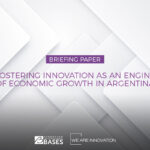Donald Trump, currently in a tight electoral race for re-election, managed to shift decades of received wisdom on trade in Washington during his time in office from 2017 to 2020. Many of the policies and objectives that were put into place during his administration have remained across President Biden’s term in office.1
While trade policy watchers seem relatively calm about the prospect of Trump’s return to the White House, they shouldn’t be. A second administration is poised to be much more radical and disruptive. The consequences of a harder US line on economic policymaking will be felt globally. Opportunities for navigating very choppy waters will be limited and the damage to global growth, economic development, and livelihoods should not be underestimated.
The challenges ahead go well beyond Trump’s own stated objectives of raising tariffs on Chinese imports to at least 60% and applying tariffs of 10-20% on all imported goods.2 Economic modelling suggests that typical American middle-class households would face higher costs of US$1,700 a year.3 Although, Trump has repeatedly argued – wrongly, according to the analysis of even US trade officials – that tariffs are paid by foreign countries rather than by US citizens. He has insisted that tariff increases did not make prices go up and that, instead, tariffs are a point of leverage and power over others.4 Under Trump 2.0, these ‘others’ won’t just include China. Trump wants to raise tariffs on every nation in the world.
Tariffs are only part of a likely Trump 2.0 agenda. The Project 2025 agenda lays out two different trade scenarios, although the chapter written by Trump’s former advisor, Peter Navarro, is perhaps more important.5 It highlights a range of policy actions that Trump’s incoming economic team will try to fully implement. It views many objectives as having only been partially achieved during his first term in office.
Trump has a long history of concern with trade, tariffs, and dependency. In 1987, Trump paid to publish his letter of complaint on trade issues, using language that has remained remarkably consistent across the decades. Trump wrote, “The world is laughing at American politicians as we protect ships we don’t own, carrying oil we don’t need, destined for allies who won’t help.” He went on to say, “It’s time for us to end our vast deficits by making Japan, and others who can afford it, pay.”6 He called for 15-20% tariffs against Japan in 1989 to get the trade deficit under control.7
Although Trump was railing against an American commitment to “free trade,” the US, like every other country, has never followed a pure “free trade” model. Countries have progressively lowered certain barriers to trade, particularly tariff rates on imported goods, although trade flows have continued to be managed by a range of policy choices like customs and border protection rules, restrictions on investment, licensing and qualification requirements, and health and safety standards. But the overall objective of US policy since the 1950s had been to allow trade in goods, services, and investments to flow relatively freely, and to lower barriers in conjunction with others through multilateral mechanisms like the General Agreement on Tariffs and Trade (GATT) and the World Trade Organization (WTO).
Such market opening commitments may be easier to bear, considering the relatively limited size of international trade as part of the US economy. Globally, trade as a percentage of gross domestic product (GDP) reached 62% in 2022.8 The comparable figure for the US is just 27%. This is quite different than, say, Singapore where trade typically averages more than 300% of domestic GDP.9
However, the US trade-to-GDP ratio is still entirely too high for Trump. His US Trade Representative (USTR), Robert Lighthizer, has written a thundering attack on free trade, with a particular focus on the perils for the US of developing a manufacturing dependency. Manufacturing, he asserts in his book, No Trade is Free, is the critical element to support America’s working people. A primary role of government, he says, is to grow manufacturing jobs as these positions provide workers with dignity and a path to higher wages. 10 An unbalanced flow of trade in goods, therefore, is an assault on US prosperity, making nothing more urgent than restoring manufacturing jobs.11
Given Lighthizer’s likely prominent role in a second Trump administration, it is worth looking at his book in careful detail. Before becoming USTR, Lighthizer had several decades of lucrative experience defending US companies, and especially steel manufacturers, against imports. He also served as a Deputy USTR under President Ronald Reagan, where he was an early architect of several US trade policies, including Section 301 on unfair trade as well as quantitative limits on vehicle and semiconductor imports. He believes these should be primary tools in Trump 2.0 along with an array of Cold War-era weapons like the International Emergency Economic Powers Act (IEEPA).
Unlike most Trump officials, Lighthizer remained in office until the end of Trump’s term, has maintained a solid relationship with Trump since leaving office, and has been widely tipped to return to Trump’s cabinet, though with a potentially different title (Treasury Secretary, perhaps?) and a wider economic policy remit.
Lighthizer’s ideas for tackling what he sees as unfair trade practices with China include not just significant tariff rate hikes, but the elimination of China’s Most Favored Nation (MFN) status (now called Permanent Normal Trade Relations or PNTR in the US).12 He favors the introduction of a range of increasingly tight controls on both inbound and outbound investment, the elimination of all Chinese inputs to a wide array of US goods and services, particularly in technology, much stronger export controls, and “reciprocity” of market access.
To accomplish his objectives, Lighthizer is very familiar with, and prepared to use, any and all unilateral trade tools. For example, he says he wanted to use the IEEPA to limit Chinese investment in US technology. While he was blocked from taking this action by the US Treasury department, leading to what he calls his “one regret,” this constraint may no longer be in his way in a Trump 2.0 cabinet.13
During his first term, Lighthizer and Trump managed to secure a Phase One trade agreement with China. Lighthizer’s book recounts the process of getting an agreement, including an interesting detour through the difficulties of getting Trump to understand the differences between a Memorandum of Understanding (MOU) in trade and a standard real estate contract. The Phase One deal also came with purchasing requirements, which Lighthizer largely glosses over in his book.
Another aspect of Trump 2.0 may be found in re-examining the Phase One commitments as described by Lighthizer. Most elements of the agreement have never been, he argues, sufficiently implemented, including China’s promises to better protect intellectual property, avoid technology transfer, open China’s agricultural markets, and allow US firms greater financial services access. Hence, a new Trump term will likely focus on the implementation and enforcement of the Phase One agreement and a possible return to issues that were not adequately addressed in the first set of negotiations.
Lighthizer wants to raise tariffs high enough to offset the “unfair” trade balance the US runs with others, especially China. Tariffs are to be ratcheted higher and higher until America’s trade in goods comes into balance with various trade partners.
Lighthizer is not the only Trump 2.0 economic potentate to support higher tariffs. Peter Navarro, another Trump advisor, has repeatedly called for “reciprocal tariffs,” i.e., the US would impose whatever tariff rates are used by US partners, “matching” a 10% tariff on US automobiles entering the EU to an equal 10% tariff (up from 2.5% now) for European autos entering the US.14 The Trump Reciprocal Trade Act is part of the Republican Party Platform.15 The impact of such reciprocal actions would be felt especially keenly by many developing countries that currently have in place higher tariffs than the US, a legacy of their accession negotiations at the WTO to which developed economies, including the US, agreed to.
Lighthizer intends to use the revenue collected through tariffs to help redress the US fiscal deficit, although clearly tariffs high enough to block trade means that there will be no revenue to collect since such trade would likely cease. He also argues that China cannot sufficiently retaliate against US actions, since, according to his reasoning, the bilateral trade deficit means that China does not have enough goods to tariff. This ignores any other non-tariff actions that China (or any other government) might – and does – take. However, if China (or others) were to react, Lighthizer would likely cheer as any non-tariff actions would support his overall objective of strategic decoupling.
Lighthizer’s other trade-related suggestions include even more unilateral measures. By definition, regional and global trade rules will not constrain US actions. He does not see why any trade agreements should “last forever.” Lighthizer’s book dwells on the specific problems of the dispute settlement system in the WTO, but his proposed solutions go beyond simply fixing this problem to essentially gutting the entire organization. He is happy to use the size and power of the US market to get others to do what the US wants.
For instance, Lighthizer has advocated adjusting the value of the US dollar to help support a balanced trade account. It’s unclear how exactly he intends to make this happen, but he suggests the use of ever-escalating US tariffs as a point of leverage to get other nations to devalue their currencies relative to the dollar. He is equally willing to take on what he sees as an inherent weakness of the US tax system by imposing a border adjustment tax to level out the advantages he sees in Value Added Taxes (VATs) used by (nearly) everyone else.
Lighthizer also suggests policies that have not been part of the Republican playbook. He is comfortable imposing border taxes to account for climate impacts and writes approvingly about using unilateral trade tools to stop labor and human rights violations by foreign trade partners.
The conclusion to Lighthizer’s book starts with an apocalyptic vision of the United States that mirrors Trump’s campaign rhetoric. It suggests that a brighter future is only possible if the shift in US trade policy entrenched by Trump 1.0 is continued and deepened. The “aircraft carrier of bad policy and poor results” has begun to turn, Lighthizer argues, but every available tool needs to be employed to ensure the future is brighter.
In Trump 2.0, unfair trade practices, especially with China but also with some of America’s closest allies and partners, need to be stamped out and the power of the US market should be regarded as a weapon to re-level the playing field. Import laws should reflect US priorities and subsidies are to be encouraged. Finally, then, trade will be forced back into “balance.”
These prescriptions should be read carefully by all US trading partners. The aircraft carrier of trade policy has changed course and will continue to do so under a Trump 2.0 administration. The initial change in direction can appear modest, but a carrier’s momentum can quickly pick up speed. While the rest of the world navigated Trump 1.0 and even managed to find ways to survive, the prospects under Trump 2.0 are looking much, much messier.
* Dr. Elms is Head of Trade Policy at the Hinrich Foundation in Singapore. Prior to joining the Foundation, she was the Executive Director and Founder of the Asian Trade Centre (ATC). She was also President of the Asia Business Trade Association (ABTA) and the Board Director of the Asian Trade Centre Foundation (ATCF).
Source: Hinrich Foundation











